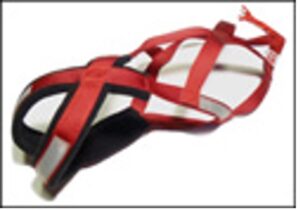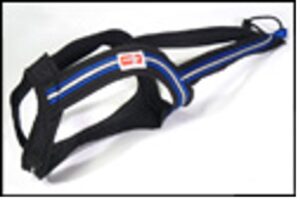Skijoring
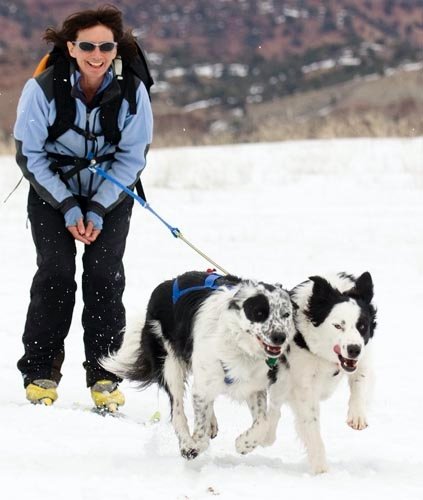
Skijoring
Skijoring is cross-country skiing while being pulled by your dog(s). It is a sport that originated in Scandinavia several hundred years ago and is quickly gaining popularity States side. One type of skijoring is done behind horses. However, I teach skijoring as a team sport with you and your dog. Dog skijoring shares many traditions with dog sledding, and sled dog clubs and races often have a skijor component.
Skijoring can be done on any type of cross country ski. At slower speeds or in deeper snow, it is done on classic or touring skis…even backcounty skis! At faster speeds and on groomed trails, skate skiing is often the preferred choice.
Skijoring FAQs
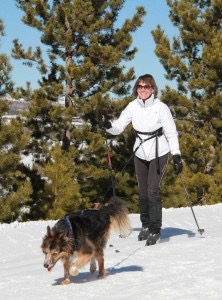 Skijoring is FUN. Skijoring is a healthy way for people to get outdoors with their canine companions. It is also a fantastic way for both you and your dog to get exercise in the winter. As a team sport, it builds and enhances the relationship between you and your dog as you learn to work together. It is easy to learn and to enjoy.
Skijoring is FUN. Skijoring is a healthy way for people to get outdoors with their canine companions. It is also a fantastic way for both you and your dog to get exercise in the winter. As a team sport, it builds and enhances the relationship between you and your dog as you learn to work together. It is easy to learn and to enjoy.
The equipment attaches dogs and owners via a bungee cord lead (see our equipment section for more details) Thus, at cross country ski areas where dog trails require leashes, or in Wilderness areas, you can still ski, have your hands free and get exercise with your dog while being in compliance with leash regulations.
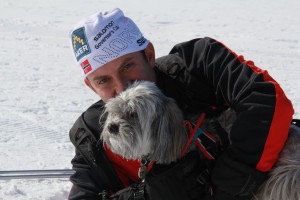 A rule of thumb is that any healthy dog over 30 pounds who likes to pull can skijor. However, from my experience, I am willing to give pretty much any dog a chance if it makes sense and if the dog is healthy. Be sure that your dog is in good health, has plenty of water and that their joints are also in good health.
A rule of thumb is that any healthy dog over 30 pounds who likes to pull can skijor. However, from my experience, I am willing to give pretty much any dog a chance if it makes sense and if the dog is healthy. Be sure that your dog is in good health, has plenty of water and that their joints are also in good health.
Dogs one year or under should not yet skijor as their growth plates have not finished. Please wait until your dog is physically mature and their joints are ready for the stress of pulling. We all want to make sure your dog will have a healthy, long and active life! If you have any questions, you should consult your veterinarian.
Some dogs will catch on quickly while others take some more training and coaching. Whether or not your dog is fast or slow, the ultimate goal is to become a team that enjoys this sport together. In private lessons and public workshops we work with all types of dogs, and using positive, gentle techniques to help your dog learn to pull.
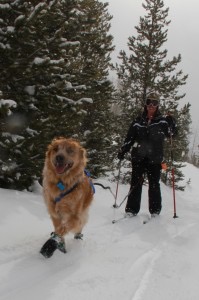 You need to be an intermediate level cross country skier. You should be comfortable on cross country skis and able to stop, slow down and change direction before hooking yourself up to your dog. If you want to travel at fast speeds on groomed trails we would recommend learning skate skiing as well.
You need to be an intermediate level cross country skier. You should be comfortable on cross country skis and able to stop, slow down and change direction before hooking yourself up to your dog. If you want to travel at fast speeds on groomed trails we would recommend learning skate skiing as well.
A basic level of fitness on your part is also required. Remember this is a team sport. You are actively skiing while your dog is pulling. Being able to sustain a 5 km ski at a comfortable pace without your dog would be recommended before hooking up to your dog.
Note: Because skijoring is both a human and dog powered sport, it is done with cross country skis not downhill skis. It is necessary to have your heels free for propulsion.
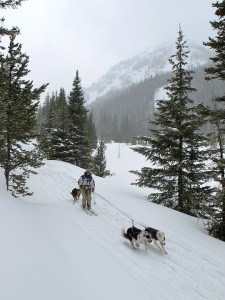 In a basic skijoring workshop, we will have an indoor session (where I can get your attention before you are hooked up to your dog!) in which we will go over equipment, dog care, training, places to skijor etc. Then we will move outside on the snow. In a beginning session we will work on getting your dog to pull, learning and teaching “let’s go” /”hike”, “whoa”/stop. and “on by” commands. You will also become familiar with how to handle the lines.
In a basic skijoring workshop, we will have an indoor session (where I can get your attention before you are hooked up to your dog!) in which we will go over equipment, dog care, training, places to skijor etc. Then we will move outside on the snow. In a beginning session we will work on getting your dog to pull, learning and teaching “let’s go” /”hike”, “whoa”/stop. and “on by” commands. You will also become familiar with how to handle the lines.
In more advanced classes we will do more of a skijor tour together and also work on the “gee”/right. “haw”/left, “come around”, “line out”, “gee over” and “haw over” as well as ALWAYS working on the most important “on by”.
All of my workshops are BYOD (bring you own dog). Skijoring is a great way to enchance and enrich the relationship you have with your own dog or dogs. My dogs are my pets and companions first and foremost. While they help me teach the workshops, I do not loan them out.
Several Nordic centers in Colorado have dog trails for skijoring, including Breckenridge Nordic Center, Crested Butte Nordic Center, Devil’s Thumb Ranch, Gold Run Nordic Center, Snow Mountain Ranch and Tennessee Mountain Nordic Center. The extent of dog friendly trail systems varies per center. Call ahead for details and please follow dog regulations. More Nordic center information can be found at ColoradoCrossCountry.com
Additionally, Colorado has miles of back country trails just waiting to be explored by you and your dog. Learn about how to travel safely in avalanche terrain. Remember, you must make important decisions for both you and your dog.
Weather and Avalanche information can be found Colorado Avalanche Information Center. Also, please follow USFS and Wilderness area regulations.
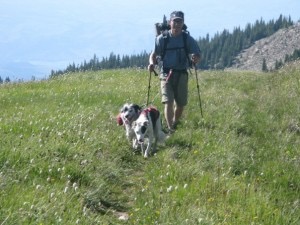 Canicross is running or hiking with your dog using the same harness and lead setup you have been using to skijor. Some people like to use a lighter belt or shorter lead for this (see our equipment section). Again, when hiking and camping in Wilderness areas, this set up takes care of leash regulations!
Canicross is running or hiking with your dog using the same harness and lead setup you have been using to skijor. Some people like to use a lighter belt or shorter lead for this (see our equipment section). Again, when hiking and camping in Wilderness areas, this set up takes care of leash regulations!
The Canicross set up also allows dog owners to Nordic walk. Nordic walking is another fast growing sport in both Europe and the United States and Canada. Nordic walking is walking using Nordic ski poles and the upper body motions used while cross country ski striding. It is a great low impact aerobic workout that tones your upper body as well as your legs.
You can also use the skijor line and harness hooked up to your bicycle or to a scooter in the summer months.
Skijoring Equipment
Most skijoring equipment uses:
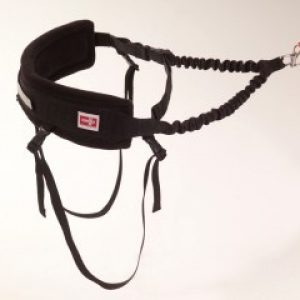
1. Belt for you
A belt that fits around the human part of the team. Belts should fit low around the waist/hip area and provide good back support. (They should not be high on your waist)
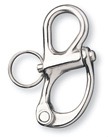
2. Quick release
A quick release from the belt to the skijor line. This allows you to release from your dog if you need to.
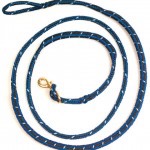
3. Bungee
A bungee towline. This is a 8 to 10 foot line with a bungee in it to lessen the stress and jerking on you and your dog. It attaches to the quick release on your harness and to the back of your dogs harness.
4. Skijor dog harness
